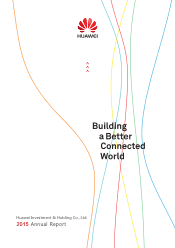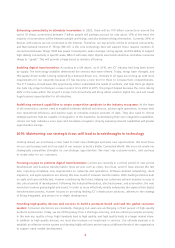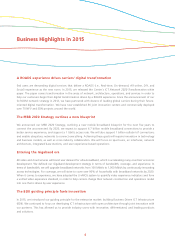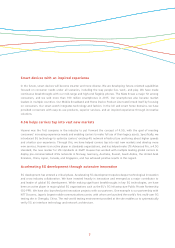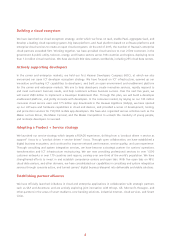Huawei 2015 Annual Report Download - page 8
Download and view the complete annual report
Please find page 8 of the 2015 Huawei annual report below. You can navigate through the pages in the report by either clicking on the pages listed below, or by using the keyword search tool below to find specific information within the annual report.
6
Business Highlights in 2015
A ROADS experience drives carriers' digital transformation
End users are demanding digital services that deliver a ROADS (i.e., Real-time, On-demand, All-online, DIY, and
Social) experience as the new norm. In 2015, we released the Carrier's ICT Network 2020 Transformation white
paper. The paper covers transformation in the areas of network, architecture, operations, and services in order to
help our customers begin their digital transformation driven by a ROADS experience. Since the announcement of our
SoftCOM network strategy in 2012, we have partnered with dozens of leading global carriers during their future-
oriented digital transformation. We have now established 36 joint innovation centers and commercially deployed
over 70 NFV and SDN projects around the world.
The MBB 2020 Strategy outlines a new blueprint
We announced our MBB 2020 Strategy, outlining a new mobile broadband blueprint for the next five years to
connect the unconnected. By 2020, we expect to support 6.7 billion mobile broadband connections to provide a
better service experience, and support a 1 Gbit/s access rate. We will also support 1 billion cellular IoT connections
and enable ubiquitous networks to connect everything. Achieving these goals will require innovation in technology
and business models, as well as cross-industry collaboration. We will focus on spectrums, air interfaces, network
architecture, integrated base stations, and user experience-based operations.
Entering the Gigaband era
4K video and cloud services will boost user demand for ultra-broadband, which is accelerating many countries' economic
development. We defined our Gigaband development strategy in terms of bandwidth, coverage, and experience. In
terms of bandwidth, we will upgrade broadband networks from 100 Mbit/s to 1,000 Mbit/s by continuously innovating
access technologies. For coverage, we will strive to cover over 90% of households with broadband networks by 2020.
When it comes to experience, we have adopted the U-vMOS system to quantify video experience indicators and form
a unified video experience standard, in order to help carriers change their network construction and operations model
into one that is driven by user experience.
The BDII guiding principle fuels innovation
In 2015, we introduced our guiding principle for the enterprise market: building Business-Driven ICT Infrastructure
(BDII). We continued to focus on developing ICT infrastructure with open architecture through joint innovation with
our partners. This has allowed us to provide industry users with innovative, differentiated, and leading products
and solutions.

